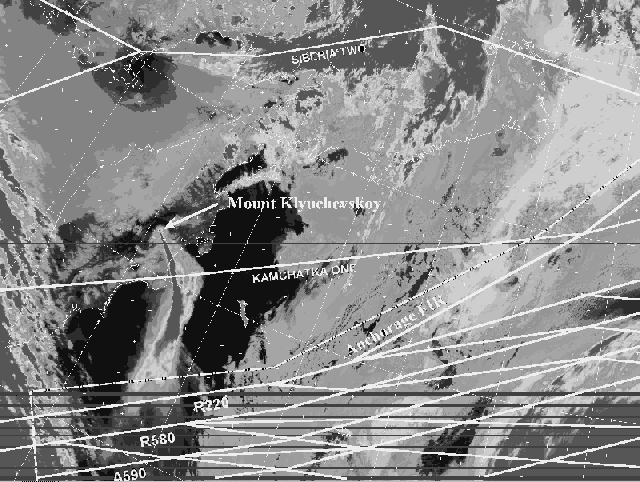
U.S. Geological Survey
Throughout the eruption, domestic and foreign air carriers received prompt notification and warning of major explosive events and ash-cloud distribution through a concerted effort by a diverse team. This team consisted of the Russian Kamchatkan Volcanic Eruption Response Team (KVERT), the Alaska Volcano Observatory (AVO)1, the Federal Aviation Administration (FAA), the National Weather Service (NWS), and the National Oceanic and Atmospheric Administration's (NOAA) Synoptic Analysis Branch (SAB) and Air Resources Laboratory (ARL). As a result of their efforts, FAA controllers successfully rerouted aircraft around the volcanic ash cloud while keeping disruption to a minimum.
Because of the potential hazard posed to flight operations, the KVERT was formed in March 1993 after extensive discussions between the AVO and the Institute of Volcanic Geology and Geochemistry (IVGG) of the Russian Academy of Sciences.
KVERT is composed chiefly of scientists from the IVGG in Petropavlovsk-Kamchatsky (and one member of AVO) and receives its information from ground observers, seismic networks, and airborne observations. An agreement between KVERT and AVO provides for AVO to disseminate information from KVERT because of the current communication difficulties in the Russian Far East. AVO has extensive communication links and notification procedures used to alert government agencies, the airlines, and the public of volcanic unrest and eruptions in Alaska.
When a major Kamchatkan eruption occurs, KVERT contacts AVO by phone on a leased line from Petropavlovsk-Kamchatsky after first notifying Russian government agencies and airlines. Primary and secondary phone contacts and arrangements for notification during non-business hours are established.
The reporting of minor activity and routine events at Kamchatkan volcanoes is by use of electronic mail. AVO disseminates the information by means of a KVERT Information Release (IR) to groups outside Russia specifically interested in Kamchatkan eruptions.
When informed of a major Kamchatkan eruption, AVO immediately notifies the Anchorage offices of the FAA and NWS. The NWS office at the Air Route Traffic Control Center then issues a Center Weather Advisory (CWA). The Weather Service Forecast Office (WSFO) follows with a Significant Meteorological Statement (SIGMET) if warranted. The Synoptic Analysis Branch is contacted and provides satellite interpretation of possible eruption clouds to the NWS field offices. Further information from KVERT and reliance on satellite imagery are used to provide detailed information for CWA and SIGMET preparation.

On September 30, at 0930 UTC, KVERT notified AVO by phone that as of about 3-4 hours earlier, the volcano had gone into major eruption, perhaps its largest in the past 40 years, with an ash column rising to 35,000 ft above MSL and moving southeast toward the heavily traveled NORPAC routes. AVO notified the FAA, NWS, and other parties at 0945 UTC, following the established protocol. The FAA issued a warning to airmen at 10:12 UTC and, soon after, the first of numerous CWA's. Later that day at 2230 UTC, AVO was notified by phone from KVERT that the eruption had increased and the ash column now reached 60,000-ft. Winds at the 30,000-ft level were estimated at 150 mph, and the ash was rapidly carried southeast into the NORPAC routes. This information was immediately distributed through a call-down list to the appropriate agencies and companies. IR's were distributed by fax as e-mail was received from KVERT.
The NOAA 12 infrared satellite image (see figure) taken at 0630 UTC shows a distinct volcanic ash plume emanating from Klyuchevskoy and extending south-southeast into the NORPAC routes. This imagery was available through the High Resolution Picture Transmission Image Processing System (HIPS) at the Anchorage WSFO and CWSU and, along with KVERT messages, provided detailed information for CWA and SIGMET preparation. During this time, the ARL Volcanic Ash Forecast Transport and Dispersion (VAFTAD) model began to provide key forecast guidance for the distribution of the ash-cloud and continued to do so throughout the eruption. The model yielded an accurate forecast of the ash-cloud position over the next 12-48 hours.
The first pilot reports of volcanic ash were at 2005 and 2010 UTC on September 30 when a thin layer of ash up to 50 miles wide was reported at 51 deg. 26 min. N, 163 deg. 30 min. E. Many additional pilot reports of ash were received for the next 49 hours in NORPAC flight routes R220, R580, G583 (KAMCHATKA 1), A590, and A591 as far as 640 miles southeast of Klyuchevskoy volcano. Ash was reported at altitudes ranging from 30,000 to 38,000 ft within an area bounded by 54 deg. 41 min. N, 172 deg. 12 min. E to 50 deg. 30 min. N, 171 deg. E to 50 deg. N, 166 deg. E to 49 deg. 42 min. N, 159 deg. 19 min. E and extending back to the volcano for the first part of this period. The ash cloud moved southeast, east and then north over time, with the last reported ash at 54 deg. 56 min. N, 171 deg. 58 min. E. By 1700 UTC on October 1, the eruption began to subside and was no longer a hazard to aviation by 1700 UTC October 2. The major explosive phase of the eruption had lasted about 36 hours and was particularly intense for the 10 hours between 1800 September 30 and 0400 October 1. AVO interpreted the status of the eruption throughout its duration, forecasting probable future activity (i.e., possible additional episodes and the end of the eruption) to airlines, the FAA, and the NWS.
October 1994 FS 94-067
For more information, please contact:
Thomas P. Miller, Alaska Volcano Observatory, U.S. Geological Survey, 4200 University Drive, Anchorage, Alaska 99508
E-mail: futpm@acad3.alaska.edu
October 1994 -------------------------- FS 94-067